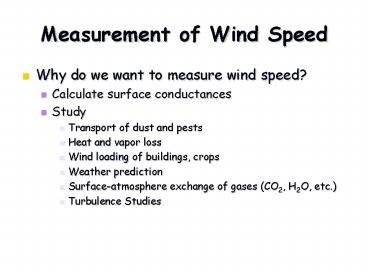Measurement of Wind Speed
1 / 17
Title:
Measurement of Wind Speed
Description:
Convenient if output of anemometer is simple linear output with wind speed ... Distance wind at new speed goes past anemometer until it reaches the same speed ... –
Number of Views:2827
Avg rating:3.0/5.0
Title: Measurement of Wind Speed
1
Measurement of Wind Speed
- Why do we want to measure wind speed?
- Calculate surface conductances
- Study
- Transport of dust and pests
- Heat and vapor loss
- Wind loading of buildings, crops
- Weather prediction
- Surface-atmosphere exchange of gases (CO2, H2O,
etc.) - Turbulence Studies
2
What makes a good Anemometer?
- Depends on what you are interested in finding
out. - Characteristics of a good anemometer
- Wide range of wind speeds for operation
- Some anemometers have threshold below which they
dont work - Some are much more accurate at one end of the
scale compared with the other - Linearity of the response
- Convenient if output of anemometer is simple
linear output with wind speed - Not as important now as we have more capable
dataloggers
3
Characteristics of Good Anemometer
- Response time
- Quick response is essential in measuring eddy
movement - Not so important for ½ hour measurements
- Size of instrument
- Larger instruments are difficult to put into
confined space - laboratory experiments
- In-canopy measurements
- Large instruments may change flow of wind in the
immediate area
4
Characteristics of Good Anemometer
- Directional Response
- Wind is a vector quantity
- Sometimes need both speed and direction
- Requires anemometer to point into wind
5
Methods for Wind Measurement Dynamic Pressure of
Wind
- Pitot Tube Anemometer
- Relies on Bernoullis Eq.
- Compares static pressure (air pressure) with
dynamic pressure (pressure of wind) - Where u is wind speed and ? is density
- Used on airplanes
- Used in wind tunnels
- Not in Environmental measurement
- No directional component
6
Force or Drag Anemometer
- Pressure Plate Anemometer
- Simplest kind
- Hinged plate
- Marked with calibrated wind speeds
- Problems
- Not particularly accurate
- Not very precise
- No measurement at low wind speeds
- Uses
- Fertilizer application
- Rough wind speed measurement
7
Force or Drag Anemometers
- Cup anemometer
- Most familiar to general public
- 3 or 6 cups turning about axis
- Low friction bearings
- Wind causes higher drag on front side of cups
- Measure shaft rotation
- Reed switch
- Light chopper
- Tachometer Generator
8
Parameters for Cup Anemometers
- Threshold
- Wind speed at which cups begin to rotate gt stop
rotating - Results from friction of the shaft (Cf, static gt
Cf, dynamic) - Typically 0.1 to 0.4 m s-1
- Linearity
- Helpful in data analysis but not nearly as
important these days - Response time/distance
- Time constant of anemometer
- Distance wind at new speed goes past anemometer
until it reaches the same speed - How do you get response distance?
9
Propeller Anemometer
- Similar principle to cup anemometer drag force
- Differs in
- Light weight propellers
- Unidirectional
- Must find a way to point to the wind
10
Propeller Anemometer
- Much better capability for low wind speeds
- Somewhat more expensive
- Must be oriented into mean wind direction
- On a swiveling base
- Using three perpendicular anemometers
11
Hot Wire Anemometer
- Ts Ta inversely proportional to wind speed
- Why?
- Two types
- Constant temperature
- Heat to constant temperature
- Look at energy required to maintain temperature
- Constant Current
- Measure temperature change with constant heating
current
12
Hot Wire Anemometers
- Both types - high sensitivity at low wind speed
- Constant current anemometer - too sensitive at
low wind speed - and not very sensitive at very high wind
speed - Constant temperature anemometer complex
temperature control circuitry
13
Sonic Anemometer
- Measures difference in travel time of sound
between transducers - Sound travels faster in direction of wind flow
- Lowers speed against wind
- Advantages
- High speed measurements
- Less than 100 ms
- No threshold
- Linear output
- Disadvantages
- Expensive, can be delicate
14
Todays Lab
- Use propeller anemometer to calibrate wind tunnel
wind speed settings
15
Todays Lab
- Calibrate cup and plate anemometers
- Measure the starting and stopping thresholds of
the cup anemometer - Observe and discuss sonic anemometers
16
Todays Lab
- Check theoretical agreement of a heated needle
anemometer - cp (air) 29.3 J mol-1 K-1
- diameterneedle 1.27mm
- Lneedle 60mm
- Rheater 69.3 ohms
- Vheater 2.4V
- Tnon-heated needle read from datalogger
- Theated needle read from datalogger
17
Todays Lab
- d characteristic dimension
- Cylinder with fluid flow along axis, d is length
of cylinder - Cylinder with fluid flow normal to axis, d is
diameter of cylinder































